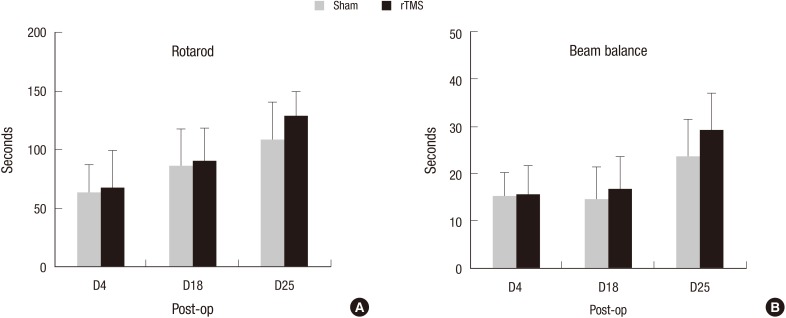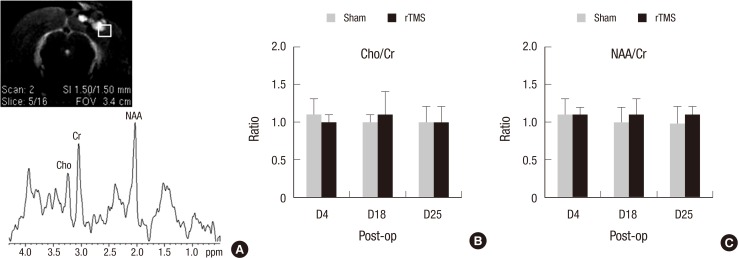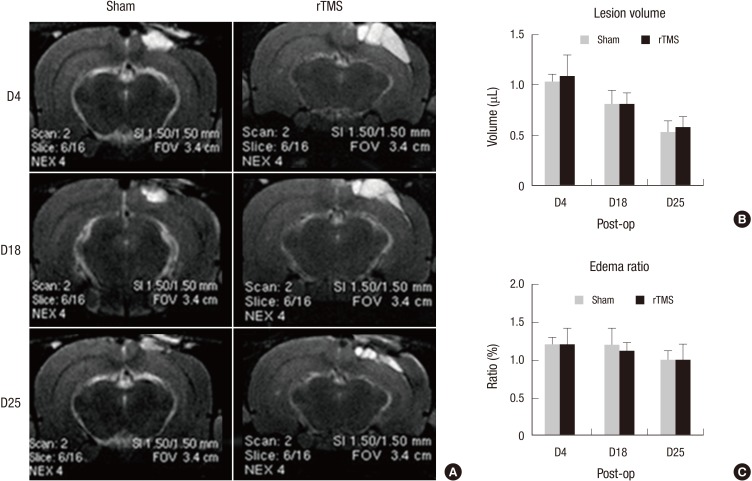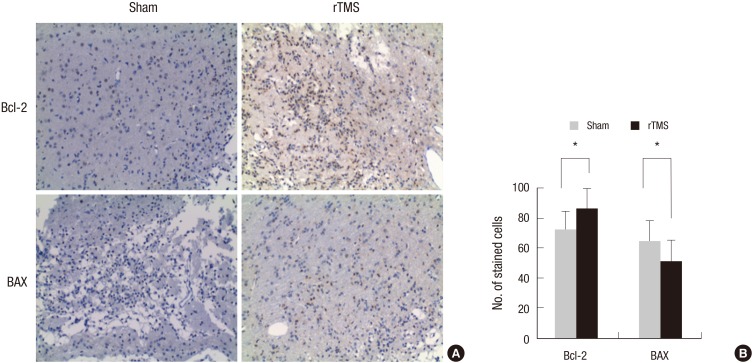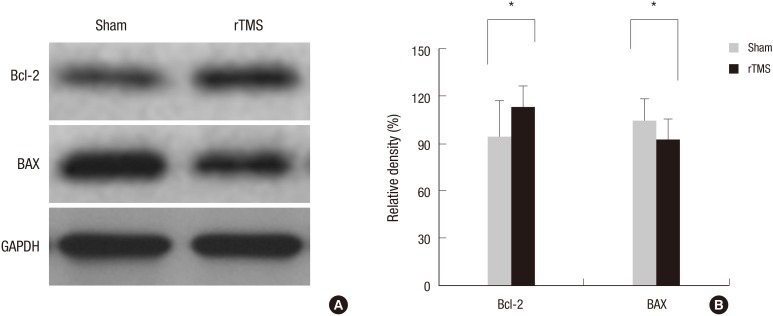Abstract
Repetitive transcranial magnetic stimulation (rTMS) is a promising technique that modulates neural networks. However, there were few studies evaluating the effects of rTMS in traumatic brain injury (TBI). Herein, we assessed the effectiveness of rTMS on behavioral recovery and metabolic changes using brain magnetic resonance spectroscopy (MRS) in a rat model of TBI. We also evaluated the safety of rTMS by measuring brain swelling with brain magnetic resonance imaging (MRI). Twenty male Sprague-Dawley rats underwent lateral fluid percussion and were randomly assigned to the sham (n=10) or the rTMS (n=10) group. rTMS was applied on the fourth day after TBI and consisted of 10 daily sessions for 2 weeks with 10 Hz frequency (total pulses=3,000). Although the rTMS group showed an anti-apoptotic effect around the peri-lesional area, functional improvements were not significantly different between the two groups. Additionally, rTMS did not modulate brain metabolites in MRS, nor was there any change of brain lesion or edema after magnetic stimulation. These data suggest that rTMS did not have beneficial effects on motor recovery during early stages of TBI, although an anti-apoptosis was observed in the peri-lesional area.
Keywords: Transcranial Magnetic Stimulation, Brain Injury, Apoptosis, Recovery, Bcl-2, BAX, TBI, rTMS
INTRODUCTION
Traumatic brain injury (TBI) is a major cause of death and persistent disability, and functional recovery often requires extensive rehabilitation (1). Although direct mechanical insult is the main mechanism behind TBI, additional programmed cell death or apoptosis may lead to neuronal and glial cell loss (2,3). Previous trials demonstrated that anti-apoptotic effects improved histological and functional outcomes after TBI (4,5). In addition, neuronal plasticity has a major role in functional recovery after TBI (6,7).
Repetitive transcranial magnetic stimulation (rTMS) is a non-invasive intervention that modulates neural connectivity. Rapid magnetic field changes in the stimulation coil induce electric currents in cortical areas, which are thought to reversibly modulate neuronal circuits by depolarizing cortical neurons (8,9,10). Previous clinical trials showed that rTMS has beneficial effects on functional recovery after stroke (11,12,13). One of the proposed therapeutic mechanisms of rTMS is anti-apoptosis, putatively by increasing B-cell lymphoma 2 (Bcl-2) expression (14,15).
Till now, there are few trials which have examined the effects of rTMS on motor recovery after TBI. The purposes of this study were to investigate the effect of rTMS on behavioral recovery during the early stage of TBI in a rat model.
MATERIALS AND METHODS
Adult male Sprague-Dawley rats (n=20, 240-280 g) were housed in laboratory cages in a controlled environment (22.0-24.0℃) and were maintained under a 12/12 hr light/dark cycle with free access to food and water.
Rats underwent lateral fluid percussion for induction of TBI as described previously (16). Briefly, rats were anesthetized with an intraperitoneal injection of 1.0% ketamine (30 mg/kg, Ketara; YuhanYanghang, Seoul, Korea). A heating pad was used to maintain the body temperature at 37±0.5℃ throughout the procedure. The skull was cleaned with a topical depilatory agent and betadine solution, and a 3-mm craniectomy was performed 1.5 mm to the right of the midline bregma over the primary motor cortex without penetrating the dura (Fig. 1A) (17). A female Luer-Lock fitting was secured over the craniectomy site with ethyl methacrylate. A saline-filled injury device (Model 211 B4, Kistler Instrumental Corp., Amherst, NY, USA) was attached to the rat via a Leur-Lock. A single moderate severity pulse (3.5-4.0 atm pressure) was delivered by rapidly injecting a bolus of saline into the craniectomy site.
Fig. 1. Schematic location of the 3-mm craniectomy, which was performed at 1.5 mm to the right of the midline bregma over the primary motor cortex (A). Stimulation method of rTMS (B). Rats underwent ten daily sessions for two weeks. Each daily session consisted of 15 trains of 2 sec at a rate of 10 Hz, 80% intensity of the RMT with a 1-sec inter-train interval (3,000 impulses total). B, bregma; rTMS, repetitive transcranial magnetic stimulation; RMT, resting motor threshold.
Twenty TBI rats were randomly assigned to either the rTMS (n=10) group or the sham (n=10) group. The rTMS group received 10 sessions of stimulation over a 2-week period beginning on the fourth day after TBI. Each daily session consisted of 15 trains of 2 sec at a rate of 10 Hz with a 1-sec inter-train interval (a total of 3,000 impulses; Fig. 1B). The stimulation coil was set tangentially above the stimulation site. For sham stimulation, the TBI rats were stimulated with a sham coil that produced the same noise as the real magnetic coil.
Rotarod and beam balance tests were performed on post-injury days 4 (before rTMS), 18 (after ten sessions of rTMS), and 25 by a blinded investigator. Brain magnetic resonance imaging (MRI) and magnetic resonance spectroscopy (MRS) were performed on post-injury days 4, 18, and 25. There were no fatalities in either group during the experiment. Rats were sacrificed after the last evaluation, and the brains were collected for western blot and immunohistochemical analyses.
A Magstim rapid2 magnetic stimulator (Magstim Co., Whitland, Defeld, UK) with a figure-of-eight coil (12-mm inner diameter, 20-mm outer diameter, 3.5-T peak magnetic field) was used in conscious rats, as described previously (15). Biphasic stimulation with a clockwise current was applied using a 400-µs pulse. Motor evoked potentials (MEPs) in the biceps femoris muscle of the weak hind limb were measured using a Sapphire Premier device (Medelec, Old Woking, Surrey, UK), by a previous described method (18). Briefly, the rats were stimulated at the site at which the stimulus of a slightly suprathreshold intensity produced the largest peak-to-peak MEP amplitude in the biceps femoris.
The effects of rTMS on cortical modulation also depend on the stimulation intensity. Previous trials in which 80% to 130% of the resting motor threshold (RMT) was applied showed therapeutic benefits in stroke management (19). To maximize the safety of rTMS for treatment of TBI, the stimulation intensity used in this study was 80% of the RMT, the lowest possible therapeutic intensity. Additionally, our previous study showed that 80% of the RMT intensity had beneficial effects on motor recovery in a stroke rat model (15). RMT was defined as the lowest stimulator output at which the peak-to-peak MEP amplitude was greater than 5% of its maximal amplitude in at least five of the ten trials.
Rotarod and beam balance tests were performed to assess motor coordination and balance ability. Rats were put on the rotarod at an initial speed of 4 rpm, and the speed was increased to 40 rpm over the course of four minutes. For the beam balance test, rats were placed in the center of a wooden rectangular beam (60 cm in length and 1.5 cm in diameter), which was set horizontally and suspended 40 cm above a foam pad. In both tests, the time to fall was measured. Each test was administered three times by a blinded researcher, and the results were averaged.
Rats were placed on a 4.7-T Bruker Biospec Imager (Bruker Medical Systems, Karlsruhe, Germany) and anesthetized with an intraperitoneal injection of 1.0% ketamine. Intact hemispheric volume (VIH), lesioned hemispheric volume (VLH), and lesion volume were measured using Paravision 3.0 software (Bruker Biospec, Ettlingen, Germany) by a blinded rater. Tissue-processing artifacts were minimized by calculating the edema ratio as follows: edema ratio=VLH/VIH×100 (20). The voxel of interest was selected over the peri-lesional site (3×3×3 µL) of the subcortical area on a T2-weighted image (T2WI). All raw spectroscopic data were processed using the Bruker's XWIN-NMR software installed in the MRI system. The metabolites were identified by the chemical shifts as observed in the MRS. The values in parts per million were as follows: choline (Cho), 3.2 ppm; creatine (Cr), 3.03 ppm; and N-acetyl-aspartate (NAA), 2.0 ppm. Cho and NAA peak areas were quantitated as relative ratios to Cr, which is constant in the brain tissue and used as a standard (21).
At post-injury day 25, rats were anesthetized with intraperitoneal injection of 1.0% ketamine and perfused transcardially with 50 mL of phosphate-buffered saline (PBS) and another 50 mL of 4% paraformaldehyde in 0.1 M/L PBS. The brains were removed, fixed in 10% neutral-buffered formalin, dehydrated in a graded ethanol series, and embedded in paraffin for immunohistochemistry, and they were obtained from the peri-lesional area. Each block was sectioned at a 6 µm-thickness and mounted on poly-L-lysine coated slides. These slides underwent a serial process of deparaffinization with xylene, dehydration with ethanol, washing with saline, and microwave in citrate buffer for 10 min. Hydrogen peroxide was used to block endogenous peroxidase activity for 30 min to reduce the non-specific immunoreactivity. Primary antibodies against B-cell lymphoma 2 (Bcl-2, 1/100, Abcam, Cambridge, MA, USA) and Bcl-2 associated X protein (BAX, 1/100, Abcam) were employed. Bcl-2 and BAX are anti-apoptotic proteins, as previously described (22). Anti-mouse, HRP/DAB (Labvision, Fremont, CA, USA) was used as the secondary antibody. Immunostained sections were digitized using a 400×objective (Leica DFC 290, Leica, Heerbrugg, Germany) in conjunction with the Leica Application suite (version 3.3.0, Leica). Five views obtained from the peri-lesional area were evaluated by a blinded pathologist, and the stained cells were counted and averaged.
Brains were removed at post-injury day 25 and frozen at -20℃ for western blots. The tissues from the peri-lesional area in brains were selected for the blots. Proteins were extracted with a series of procedures including mixing with the protein extraction solution, homogenization by vortexing for 5 min, and harvesting the supernatants after centrifugation for 10 min at 15,000 rpm. Total protein amounts were assayed with the Bradford's method. Proteins were resolved on a SDS-PAGE gel, and blotting was performed for 90 min. Primary antibodies were applied onto the nitrocellulose membrane for 2 hr. After washing, secondary antibodies were added to the membrane for 1 hr. Primary antibodies against B-cell lymphoma 2 (Bcl-2, 1/100, Abcam) and Bcl-2 associated X protein (BAX, 1/1,000, Abcam) were applied for protein analyses. An antibody for glyceraldehyde-3-phosphate dehydrogenase (GAPDH) was used as a loading control. Relative band density was assessed with Image J software.
Statistical analysis was performed with PASW software package, version 18.0. Student's t-test was applied to evaluate the differences in behavioral tests, edema ratio, and metabolites between the two groups on post-injury day 4. Repeated-measures ANOVA was used to analyze behavioral tests, lesion volume, edema ratio, and relative ratios of metabolites. Immunostaining and western blot data were analyzed using the Student's t-test. P values less than 0.05 were considered significant.
Ethics statement
All protocols for this study were approved by institutional animal care and use committee at medical research institute of Kangbuk Samsung Hospital, Seoul.
RESULTS
Behavioral tests
Baseline rotarod and beam balance data on post-injury day 4 did not show significant differences between the rTMS and sham groups. There were no significant group×time interactions for the rotarod and beam balance tests among two groups (Fig. 2).
Fig. 2. Results of Rotarod (A) and beam balance tests (B). There are no significant differences between the two groups (sham, n=10 rats; rTMS, n=10 rats). D4, 4 days after injury; D18, 18 days after injury; D25, 25 days after injury.
There were no significant differences in baseline MRS data for Cho/Cr and NAA/Cr ratios between the two groups. Group×time interactions for Cho/Cr and NAA/Cr ratios were not significant among two groups (Fig. 3).
Fig. 3. Results of metabolites with MRS. T2WI showed the location of MRS voxel (white squre, 3×3×3 µL) in the peri-lesional site (A). There are no significant differences in Cho/Cr (B) or NAA/Cr (C) ratios between the two groups (sham, n=10 rats; rTMS, n=10 rats). Cho, choline; Cr, creatine; NAA, N-acetyl-aspartate; D4, 4 days after injury; D18, 18 days after injury; D25, 25 days after injury.
Brain MRI
Baseline data for brain swelling on post-injury day 4 did not show significant differences between the two groups. There was no significant group×time interaction for lesion volume or brain swelling between the groups (Fig. 4).
Fig. 4. Results of brain swelling with MRI (A). There is no significant difference in lesion volume or brain edema between the two groups (B & C). rTMS, repetitive transcranial magnetic stimulation; D4, 4 days after injury; D18, 18 days after injury; D25, 25 days after injury.
Immunohistochemistry
Immunohistochemical analyses of Bcl-2 and Bax staining showed that the rTMS group had a significantly greater number of Bcl-2 stained cells and a lesser number of BAX stained cells around the peri-lesional area compared with the sham group (P<0.05; Student's t-test; Fig. 5).
Fig. 5. Results of immunohistochemical staining with Bcl-2 and BAX (A). A significantly more number of Bcl-2 stained cells and a lesser number of BAX stained cells in the rTMS group compared with the sham group around the peri-lesional area (B). sham, n=10 rats; rTMS, n=10 rats. *P<0.05, Student's t-test. Bcl-2, B-cell lymphoma 2; BAX, Bcl-2 associated X protein; rTMS, repetitive transcranial magnetic stimulation.
Western blot
The densitometric analyses of western blots showed that the rTMS group had a significantly higher Bcl-2 expression and a lower BAX expression compared with the sham group (P<0.05; Student's t-test; Fig. 6).
Fig. 6. Results of western blot showed Bcl-2 and BAX bands (A). A significant increase in Bcl-2 expression and a decrease in BAX expression is observed in the rTMS group compared with the sham group (B). sham, n=10 rats; rTMS, n=10 rats. *P < 0.05, Student's t-test. Bcl-2, B-cell lymphoma 2; BAX, Bcl-2 associated X protein; GAPDH, glyceraldehyde-3-phosphate dehydrogenase; rTMS, repetitive transcranial magnetic stimulation.
DISCUSSION
This is the first report to investigate whether application of rTMS for TBI has a therapeutic effect on motor recovery or not. The major finding is that rTMS did not improve motor function during the early stage of TBI, although an anti-apoptotic effect was observed in the peri-lesional area without aggravation of brain injury.
Previous experiments showed that rTMS has an anti-apoptosis in the peri-ischemic areas in models of acute and subacute ischemic stroke (14,15). The peri-ischemic region, known as 'ischemic penumbra', is functionally silent due to impaired blood supply, but it sustains minimal metabolic activities (23). Therefore, most of the apoptosis is observed in the ischemic penumbra (24,25,26). In this study, the rTMS group demonstrated significantly enhanced expression of Bcl-2 and reduced expression of BAX, which are known the anti-apoptotic and pro-apoptotic proteins, respectively (Fig. 5) (22,27,28). Apoptosis triggered by TBI leads to progressive neuronal loss (2,3). However, the observed anti-apoptosis did not induce motor recovery in rat TBI model, which could indicate that the mechanical damages causing necrosis of tissue, cell swelling, and plasma membrane rupture were more significant than apoptosis in early stage of TBI (29). These could be more serious when the intensity of trauma is severe. Therefore, anti-apoptosis induced by rTMS might be unable to suppress direct cellular injury during the early stage of moderate TBI. The present results are in agreement with those of previous reports, in which Bcl-2 over-expression did not elicit functional improvement in a TBI model (30,31,32).
Additionally, the damaged brain might be more vulnerable to excitation during the early injury period. Previous studies showed that early exercise aggravated brain injury in an animal model of stroke (33,34). Considering the previous trials which reported that TBI patients require a longer recovery time than stroke patients (35,36), it can be argued that the application of rTMS to the damaged brain during the early period of injury counteracted the beneficial effects of anti-apoptosis induced by rTMS after TBI.
Cho and NAA measured by 1H MR spectroscopy are the structural component of cellular membrane and a predecessor of brain lipids, respectively (37). In states of neuronal damage, including TBI, the Cho level is expected to increase with a decrease of the NAA level. In this study, Cho/Cr and NAA/Cr ratio measured by MRS were not significantly different among the groups (Fig. 3). Additionally, MRI findings showed that lesion volume and brain edema was not improved nor aggravated after rTMS (Fig. 4). These results meant that rTMS was neutral effect on neuronal recovery or deterioration in early stage of moderate TBI.
There are some limitations to this study. First of all, we did not include a healthy group. The inclusion of these groups could have explained the therapeutic effects of rTMS compared to those in the normal control group, and it could also have helped to clarify the effect of TBI on motor function. Additionally, adverse events such as seizures or tremors were not measured during the experimental period. Therefore, we could not report any other adverse events associated with rTMS, except for lesion volume, brain edema and metabolic changes.
In conclusions, rTMS did not have beneficial effects on motor recovery during early stages of moderate TBI, although an anti-apoptosis was observed in the peri-lesional area. Although behavioral data did not support the claim that rTMS is beneficial for treatment of TBI, further studies should be performed in different periods or severities of TBI, using diverse rTMS protocols and more sensitive behavioral tests to evaluate the potential therapeutic effects of rTMS.
Footnotes
Funding: This work was supported by Samsung Biomedical Research Institute grant (2012, #SMX1132351).
DISCLOSURE: There was no potential conflict of interest in the experiment.
AUTHOR CONTRIBUTION: Chun MH designed the study and Yoon KJ performed the experiment. Lee YT provided the idea of experiment and Lee YK analyzed the data of immunohistochemistry. Chung PW analyzed data. Yoon KJ, Kim DY, and Chun MH wrote the manuscript. All authors contributed writing the article.
References
- 1.Ragnarsson KT. Results of the NIH consensus conference on "rehabilitation of persons with traumatic brain injury". Restor Neurol Neurosci. 2002;20:103–108. [PubMed] [Google Scholar]
- 2.Raghupathi R, Graham DI, McIntosh TK. Apoptosis after traumatic brain injury. J Neurotrauma. 2000;17:927–938. doi: 10.1089/neu.2000.17.927. [DOI] [PubMed] [Google Scholar]
- 3.Miñambres E, Ballesteros MA, Mayorga M, Marin MJ, Muñoz P, Figols J, López-Hoyos M. Cerebral apoptosis in severe traumatic brain injury patients: an in vitro, in vivo, and postmortem study. J Neurotrauma. 2008;25:581–591. doi: 10.1089/neu.2007.0398. [DOI] [PubMed] [Google Scholar]
- 4.Knoblach SM, Alroy DA, Nikolaeva M, Cernak I, Stoica BA, Faden AI. Caspase inhibitor z-DEVD-fmk attenuates calpain and necrotic cell death in vitro and after traumatic brain injury. J Cereb Blood Flow Metab. 2004;24:1119–1132. doi: 10.1097/01.WCB.0000138664.17682.32. [DOI] [PubMed] [Google Scholar]
- 5.Soustiel JF, Palzur E, Nevo O, Thaler I, Vlodavsky E. Neuroprotective anti-apoptosis effect of estrogens in traumatic brain injury. J Neurotrauma. 2005;22:345–352. doi: 10.1089/neu.2005.22.345. [DOI] [PubMed] [Google Scholar]
- 6.Monnerie H, Tang-Schomer MD, Iwata A, Smith DH, Kim HA, Le Roux PD. Dendritic alterations after dynamic axonal stretch injury in vitro. Exp Neurol. 2010;224:415–423. doi: 10.1016/j.expneurol.2010.05.001. [DOI] [PMC free article] [PubMed] [Google Scholar]
- 7.Hu B, Liu C, Bramlett H, Sick TJ, Alonso OF, Chen S, Dietrich WD. Changes in trkB-ERK1/2-CREB/Elk-1 pathways in hippocampal mossy fiber organization after traumatic brain injury. J Cereb Blood Flow Metab. 2004;24:934–943. doi: 10.1097/01.WCB.0000125888.56462.A1. [DOI] [PubMed] [Google Scholar]
- 8.Chouinard PA, Van Der Werf YD, Leonard G, Paus T. Modulating neural networks with transcranial magnetic stimulation applied over the dorsal premotor and primary motor cortices. J Neurophysiol. 2003;90:1071–1083. doi: 10.1152/jn.01105.2002. [DOI] [PubMed] [Google Scholar]
- 9.Siebner HR, Peller M, Willoch F, Minoshima S, Boecker H, Auer C, Drzezga A, Conrad B, Bartenstein P. Lasting cortical activation after repetitive TMS of the motor cortex: a glucose metabolic study. Neurology. 2000;54:956–963. doi: 10.1212/wnl.54.4.956. [DOI] [PubMed] [Google Scholar]
- 10.Strafella AP, Paus T. Cerebral blood-flow changes induced by paired-pulse transcranial magnetic stimulation of the primary motor cortex. J Neurophysiol. 2001;85:2624–2629. doi: 10.1152/jn.2001.85.6.2624. [DOI] [PubMed] [Google Scholar]
- 11.Khedr EM, Ahmed MA, Fathy N, Rothwell JC. Therapeutic trial of repetitive transcranial magnetic stimulation after acute ischemic stroke. Neurology. 2005;65:466–468. doi: 10.1212/01.wnl.0000173067.84247.36. [DOI] [PubMed] [Google Scholar]
- 12.Mansur CG, Fregni F, Boggio PS, Riberto M, Gallucci-Neto J, Santos CM, Wagner T, Rigonatti SP, Marcolin MA, Pascual-Leone A. A sham stimulation-controlled trial of rTMS of the unaffected hemisphere in stroke patients. Neurology. 2005;64:1802–1804. doi: 10.1212/01.WNL.0000161839.38079.92. [DOI] [PubMed] [Google Scholar]
- 13.Takeuchi N, Chuma T, Matsuo Y, Watanabe I, Ikoma K. Repetitive transcranial magnetic stimulation of contralesional primary motor cortex improves hand function after stroke. Stroke. 2005;36:2681–2686. doi: 10.1161/01.STR.0000189658.51972.34. [DOI] [PubMed] [Google Scholar]
- 14.Gao F, Wang S, Guo Y, Wang J, Lou M, Wu J, Ding M, Tian M, Zhang H. Protective effects of repetitive transcranial magnetic stimulation in a rat model of transient cerebral ischaemia: a microPET study. Eur J Nucl Med Mol Imaging. 2010;37:954–961. doi: 10.1007/s00259-009-1342-3. [DOI] [PubMed] [Google Scholar]
- 15.Yoon KJ, Lee YT, Han TR. Mechanism of functional recovery after repetitive transcranial magnetic stimulation (rTMS) in the subacute cerebral ischemic rat model: neural plasticity or anti-apoptosis? Exp Brain Res. 2011;214:549–556. doi: 10.1007/s00221-011-2853-2. [DOI] [PubMed] [Google Scholar]
- 16.McIntosh TK, Vink R, Noble L, Yamakami I, Fernyak S, Soares H, Faden AL. Traumatic brain injury in the rat: characterization of a lateral fluid-percussion model. Neuroscience. 1989;28:233–244. doi: 10.1016/0306-4522(89)90247-9. [DOI] [PubMed] [Google Scholar]
- 17.Fonoff ET, Pereira JF, Jr, Camargo LV, Dale CS, Pagano RL, Ballester G, Teixeira MJ. Functional mapping of the motor cortex of the rat using transdural electrical stimulation. Behav Brain Res. 2009;202:138–141. doi: 10.1016/j.bbr.2009.03.018. [DOI] [PubMed] [Google Scholar]
- 18.Ogiue-Ikeda M, Kawato S, Ueno S. The effect of repetitive transcranial magnetic stimulation on long-term potentiation in rat hippocampus depends on stimulus intensity. Brain Res. 2003;993:222–226. doi: 10.1016/j.brainres.2003.09.009. [DOI] [PubMed] [Google Scholar]
- 19.Fitzgerald PB, Brown TL, Daskalakis ZJ, Chen R, Kulkarni J. Intensity-dependent effects of 1 Hz rTMS on human corticospinal excitability. Clin Neurophysiol. 2002;113:1136–1141. doi: 10.1016/s1388-2457(02)00145-1. [DOI] [PubMed] [Google Scholar]
- 20.Kline RA, Negendank WG, McCoy LE, Lester M, Berguer R. MRI quantitation of edema in focal cerebral ischemia in cats: correlation with cytochrome aa3 oxidation state. Magn Reson Med. 1990;13:319–323. doi: 10.1002/mrm.1910130215. [DOI] [PubMed] [Google Scholar]
- 21.Arnold DL, Matthews PM. Practical aspects of clinical applications of MRS in the brain. In: Charles CH, Young IR, editors. MR spectroscopy: clinical applications and techniques. London: Martin Dunitz; 1996. pp. 139–159. [Google Scholar]
- 22.Antonsson B. Bax and other pro-apoptotic Bcl-2 family "killer-proteins" and their victim the mitochondrion. Cell Tissue Res. 2001;306:347–361. doi: 10.1007/s00441-001-0472-0. [DOI] [PubMed] [Google Scholar]
- 23.Ginsberg MD, Zhao W, Alonso OF, Loor-Estades JY, Dietrich WD, Busto R. Uncoupling of local cerebral glucose metabolism and blood flow after acute fluid-percussion injury in rats. Am J Physiol. 1997;272:H2859–H2868. doi: 10.1152/ajpheart.1997.272.6.H2859. [DOI] [PubMed] [Google Scholar]
- 24.Charriaut-Marlangue C, Margaill I, Represa A, Popovici T, Plotkine M, Ben-Ari Y. Apoptosis and necrosis after reversible focal ischemia: an in situ DNA fragmentation analysis. J Cereb Blood Flow Metab. 1996;16:186–194. doi: 10.1097/00004647-199603000-00002. [DOI] [PubMed] [Google Scholar]
- 25.Clemens JA, Stephenson DT, Smalstig EB, Dixon EP, Little SP. Global ischemia activates nuclear factor-kappa B in forebrain neurons of rats. Stroke. 1997;28:1073–1080. discussion 1080-1. doi: 10.1161/01.str.28.5.1073. [DOI] [PubMed] [Google Scholar]
- 26.Vexler ZS, Roberts TP, Bollen AW, Derugin N, Arieff AI. Transient cerebral ischemia. Association of apoptosis induction with hypoperfusion. J Clin Invest. 1997;99:1453–1459. doi: 10.1172/JCI119304. [DOI] [PMC free article] [PubMed] [Google Scholar]
- 27.Clark RS, Chen J, Watkins SC, Kochanek PM, Chen M, Stetler RA, Loeffert JE, Graham SH. Apoptosis-suppressor gene bcl-2 expression after traumatic brain injury in rats. J Neurosci. 1997;17:9172–9182. doi: 10.1523/JNEUROSCI.17-23-09172.1997. [DOI] [PMC free article] [PubMed] [Google Scholar]
- 28.Reed JC. Proapoptotic multidomain Bcl-2/Bax-family proteins: mechanisms, physiological roles, and therapeutic opportunities. Cell Death Differ. 2006;13:1378–1386. doi: 10.1038/sj.cdd.4401975. [DOI] [PubMed] [Google Scholar]
- 29.Verma A. Opportunities for neuroprotection in traumatic brain injury. J Head Trauma Rehabil. 2000;15:1149–1161. doi: 10.1097/00001199-200010000-00008. [DOI] [PubMed] [Google Scholar]
- 30.Raghupathi R, Fernandez SC, Murai H, Trusko SP, Scott RW, Nishioka WK, McIntosh TK. BCL-2 overexpression attenuates cortical cell loss after traumatic brain injury in transgenic mice. J Cereb Blood Flow Metab. 1998;18:1259–1269. doi: 10.1097/00004647-199811000-00013. [DOI] [PubMed] [Google Scholar]
- 31.Nakamura M, Raghupathi R, Merry DE, Scherbel U, Saatman KE, McIntosh TK. Overexpression of Bcl-2 is neuroprotective after experimental brain injury in transgenic mice. J Comp Neurol. 1999;412:681–692. doi: 10.1002/(sici)1096-9861(19991004)412:4<681::aid-cne9>3.0.co;2-f. [DOI] [PubMed] [Google Scholar]
- 32.Tehranian R, Rose ME, Vagni V, Griffith RP, Wu S, Maits S, Zhang X, Clark RS, Dixon CE, Kochanek PM, et al. Transgenic mice that overexpress the anti-apoptotic Bcl-2 protein have improved histological outcome but unchanged behavioral outcome after traumatic brain injury. Brain Res. 2006;1101:126–135. doi: 10.1016/j.brainres.2006.05.049. [DOI] [PubMed] [Google Scholar]
- 33.Humm JL, Kozlowski DA, Bland ST, James DC, Schallert T. Use-dependent exaggeration of brain injury: is glutamate involved? Exp Neurol. 1999;157:349–358. doi: 10.1006/exnr.1999.7061. [DOI] [PubMed] [Google Scholar]
- 34.Risedal A, Zeng J, Johansson BB. Early training may exacerbate brain damage after focal brain ischemia in the rat. J Cereb Blood Flow Metab. 1999;19:997–1003. doi: 10.1097/00004647-199909000-00007. [DOI] [PubMed] [Google Scholar]
- 35.Katz DI, Alexander MP, Klein RB. Recovery of arm function in patients with paresis after traumatic brain injury. Arch Phys Med Rehabil. 1998;79:488–493. doi: 10.1016/s0003-9993(98)90060-0. [DOI] [PubMed] [Google Scholar]
- 36.Jang SH. Review of motor recovery in patients with traumatic brain injury. NeuroRehabilitation. 2009;24:349–353. doi: 10.3233/NRE-2009-0489. [DOI] [PubMed] [Google Scholar]
- 37.Kornienko VN, Pronin IN. Diagnostic neuroradiology. Berlin: Springer-Verlag; 2009. pp. 18–19. [Google Scholar]




